Comprehensive Analysis of Macroeconomic Variables in China's Economy
VerifiedAdded on 2023/06/03
|19
|3601
|208
Report
AI Summary
This report delves into a comprehensive analysis of various macroeconomic variables within the Chinese economy. It meticulously examines the trends and impacts of real interest rates, government expenditures, domestic credit to the private sector, taxation policies, and government investments in infrastructure. The report further explores the exchange rate regime and its fluctuations, the monetary policy implemented in China, and the effects of the Global Financial Crisis (GFC) on the nation's economic landscape. Through the analysis of these crucial macroeconomic factors, the report provides a detailed understanding of China's economic dynamics, offering insights into the interrelationships between these variables and their implications for economic growth and stability. The report also includes relevant figures and graphs from the World Bank and other sources to support the analysis.
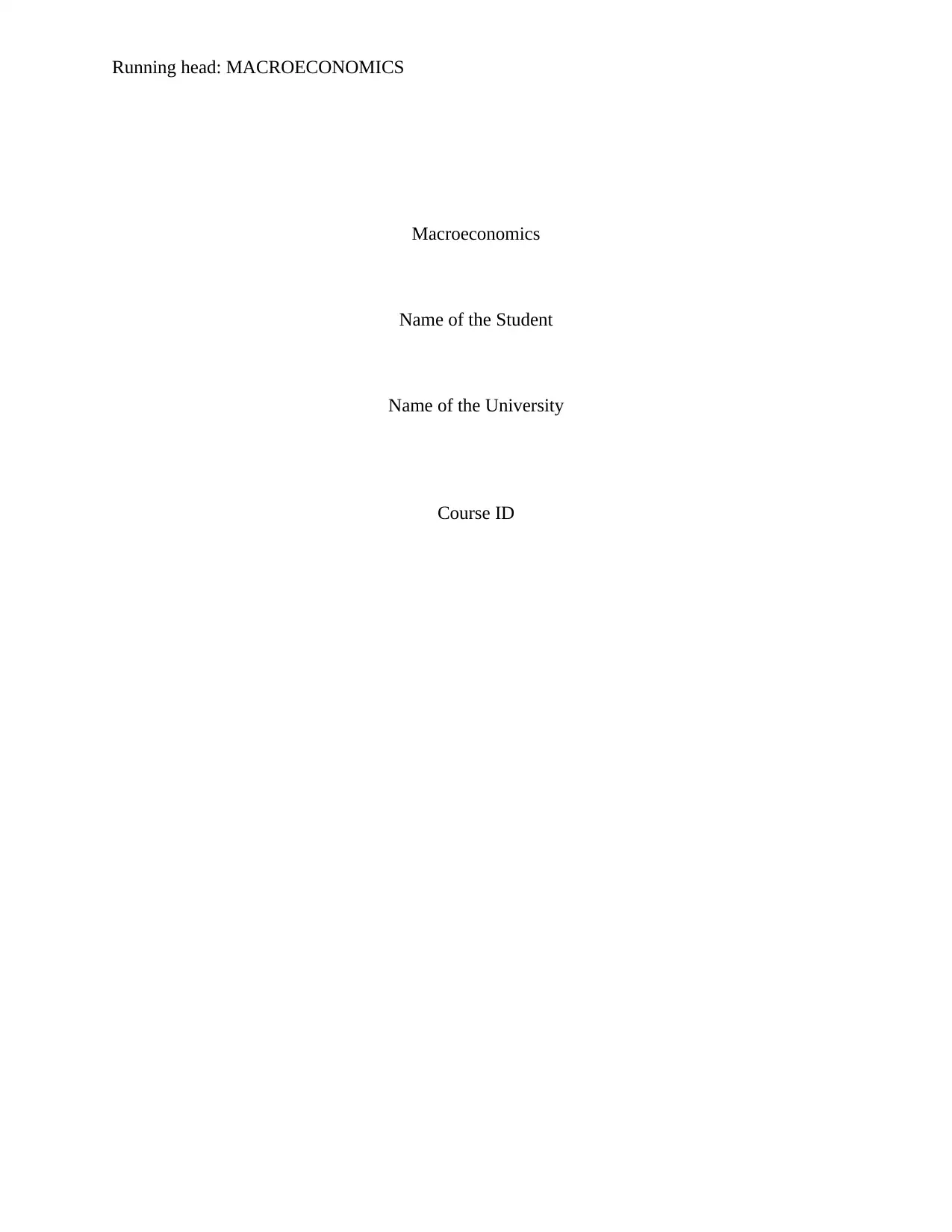
Running head: MACROECONOMICS
Macroeconomics
Name of the Student
Name of the University
Course ID
Macroeconomics
Name of the Student
Name of the University
Course ID
Paraphrase This Document
Need a fresh take? Get an instant paraphrase of this document with our AI Paraphraser
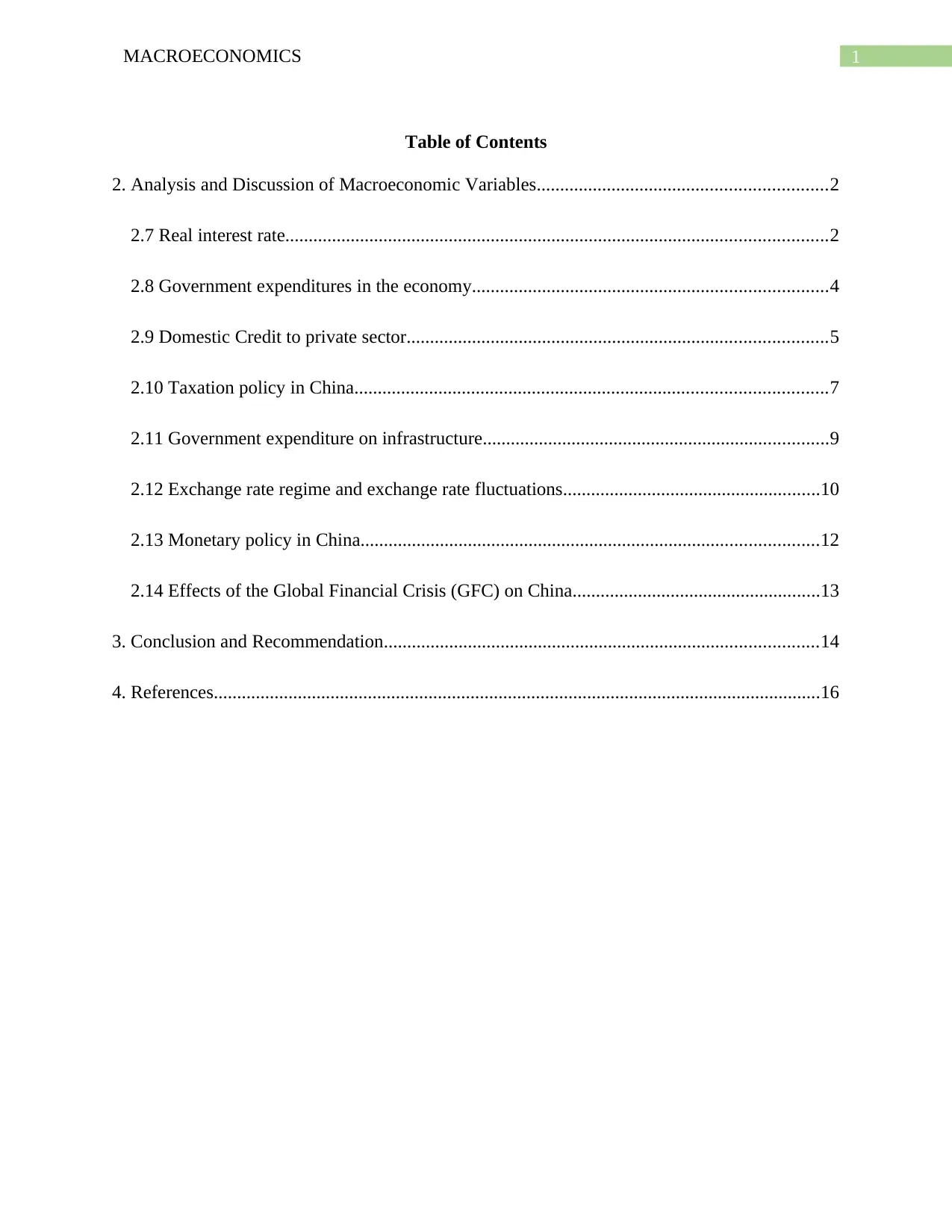
1MACROECONOMICS
Table of Contents
2. Analysis and Discussion of Macroeconomic Variables..............................................................2
2.7 Real interest rate....................................................................................................................2
2.8 Government expenditures in the economy............................................................................4
2.9 Domestic Credit to private sector..........................................................................................5
2.10 Taxation policy in China.....................................................................................................7
2.11 Government expenditure on infrastructure..........................................................................9
2.12 Exchange rate regime and exchange rate fluctuations.......................................................10
2.13 Monetary policy in China..................................................................................................12
2.14 Effects of the Global Financial Crisis (GFC) on China.....................................................13
3. Conclusion and Recommendation.............................................................................................14
4. References..................................................................................................................................16
Table of Contents
2. Analysis and Discussion of Macroeconomic Variables..............................................................2
2.7 Real interest rate....................................................................................................................2
2.8 Government expenditures in the economy............................................................................4
2.9 Domestic Credit to private sector..........................................................................................5
2.10 Taxation policy in China.....................................................................................................7
2.11 Government expenditure on infrastructure..........................................................................9
2.12 Exchange rate regime and exchange rate fluctuations.......................................................10
2.13 Monetary policy in China..................................................................................................12
2.14 Effects of the Global Financial Crisis (GFC) on China.....................................................13
3. Conclusion and Recommendation.............................................................................................14
4. References..................................................................................................................................16
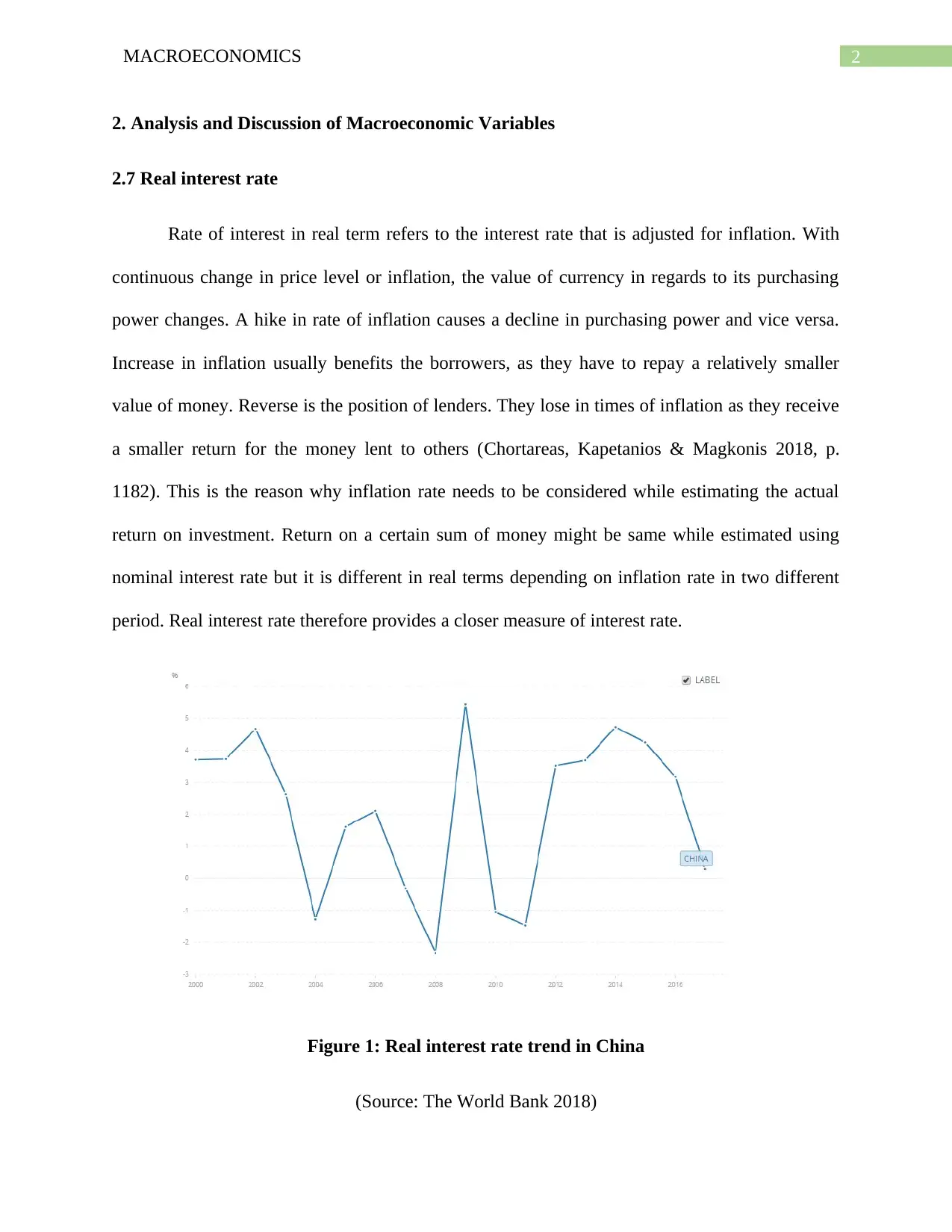
2MACROECONOMICS
2. Analysis and Discussion of Macroeconomic Variables
2.7 Real interest rate
Rate of interest in real term refers to the interest rate that is adjusted for inflation. With
continuous change in price level or inflation, the value of currency in regards to its purchasing
power changes. A hike in rate of inflation causes a decline in purchasing power and vice versa.
Increase in inflation usually benefits the borrowers, as they have to repay a relatively smaller
value of money. Reverse is the position of lenders. They lose in times of inflation as they receive
a smaller return for the money lent to others (Chortareas, Kapetanios & Magkonis 2018, p.
1182). This is the reason why inflation rate needs to be considered while estimating the actual
return on investment. Return on a certain sum of money might be same while estimated using
nominal interest rate but it is different in real terms depending on inflation rate in two different
period. Real interest rate therefore provides a closer measure of interest rate.
Figure 1: Real interest rate trend in China
(Source: The World Bank 2018)
2. Analysis and Discussion of Macroeconomic Variables
2.7 Real interest rate
Rate of interest in real term refers to the interest rate that is adjusted for inflation. With
continuous change in price level or inflation, the value of currency in regards to its purchasing
power changes. A hike in rate of inflation causes a decline in purchasing power and vice versa.
Increase in inflation usually benefits the borrowers, as they have to repay a relatively smaller
value of money. Reverse is the position of lenders. They lose in times of inflation as they receive
a smaller return for the money lent to others (Chortareas, Kapetanios & Magkonis 2018, p.
1182). This is the reason why inflation rate needs to be considered while estimating the actual
return on investment. Return on a certain sum of money might be same while estimated using
nominal interest rate but it is different in real terms depending on inflation rate in two different
period. Real interest rate therefore provides a closer measure of interest rate.
Figure 1: Real interest rate trend in China
(Source: The World Bank 2018)
⊘ This is a preview!⊘
Do you want full access?
Subscribe today to unlock all pages.

Trusted by 1+ million students worldwide
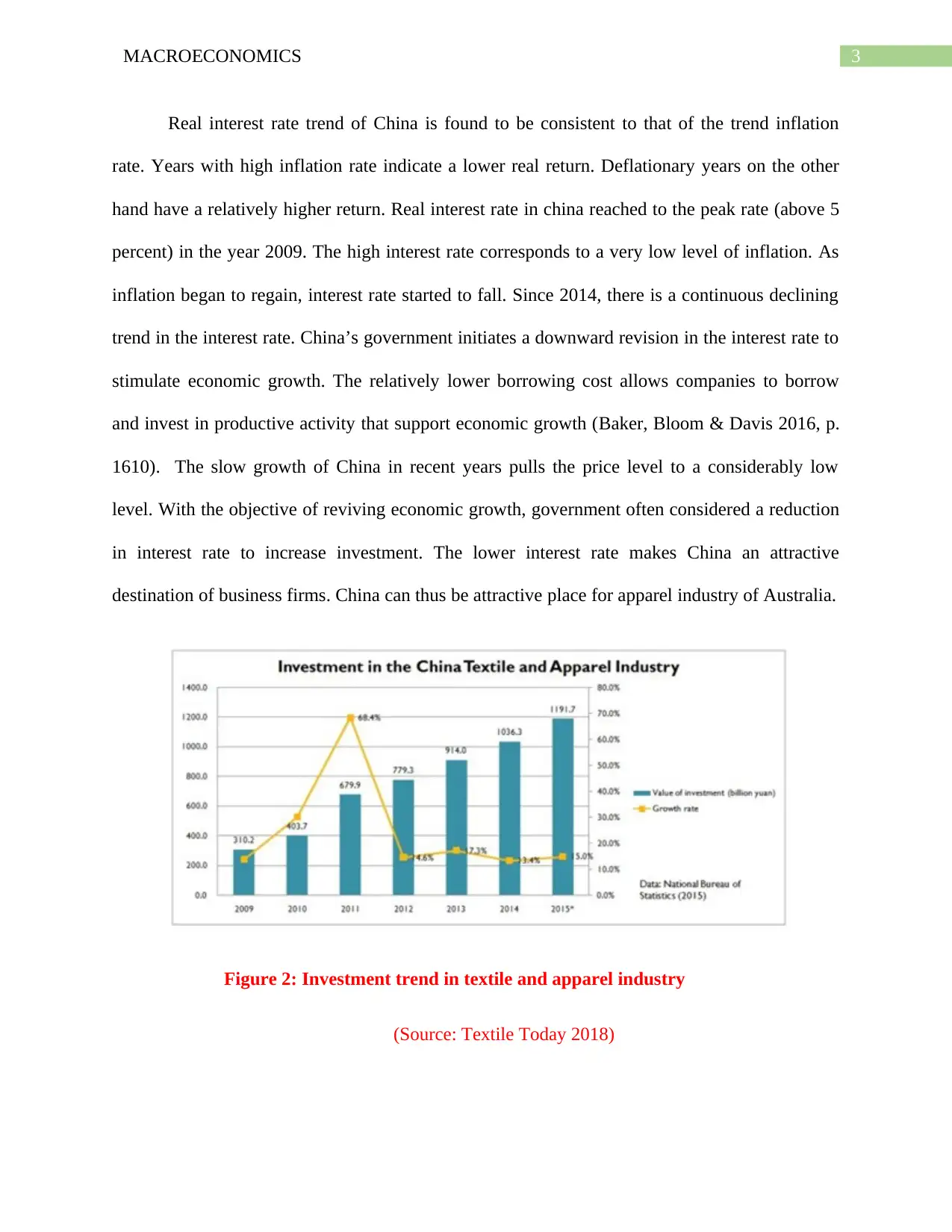
3MACROECONOMICS
Real interest rate trend of China is found to be consistent to that of the trend inflation
rate. Years with high inflation rate indicate a lower real return. Deflationary years on the other
hand have a relatively higher return. Real interest rate in china reached to the peak rate (above 5
percent) in the year 2009. The high interest rate corresponds to a very low level of inflation. As
inflation began to regain, interest rate started to fall. Since 2014, there is a continuous declining
trend in the interest rate. China’s government initiates a downward revision in the interest rate to
stimulate economic growth. The relatively lower borrowing cost allows companies to borrow
and invest in productive activity that support economic growth (Baker, Bloom & Davis 2016, p.
1610). The slow growth of China in recent years pulls the price level to a considerably low
level. With the objective of reviving economic growth, government often considered a reduction
in interest rate to increase investment. The lower interest rate makes China an attractive
destination of business firms. China can thus be attractive place for apparel industry of Australia.
Figure 2: Investment trend in textile and apparel industry
(Source: Textile Today 2018)
Real interest rate trend of China is found to be consistent to that of the trend inflation
rate. Years with high inflation rate indicate a lower real return. Deflationary years on the other
hand have a relatively higher return. Real interest rate in china reached to the peak rate (above 5
percent) in the year 2009. The high interest rate corresponds to a very low level of inflation. As
inflation began to regain, interest rate started to fall. Since 2014, there is a continuous declining
trend in the interest rate. China’s government initiates a downward revision in the interest rate to
stimulate economic growth. The relatively lower borrowing cost allows companies to borrow
and invest in productive activity that support economic growth (Baker, Bloom & Davis 2016, p.
1610). The slow growth of China in recent years pulls the price level to a considerably low
level. With the objective of reviving economic growth, government often considered a reduction
in interest rate to increase investment. The lower interest rate makes China an attractive
destination of business firms. China can thus be attractive place for apparel industry of Australia.
Figure 2: Investment trend in textile and apparel industry
(Source: Textile Today 2018)
Paraphrase This Document
Need a fresh take? Get an instant paraphrase of this document with our AI Paraphraser
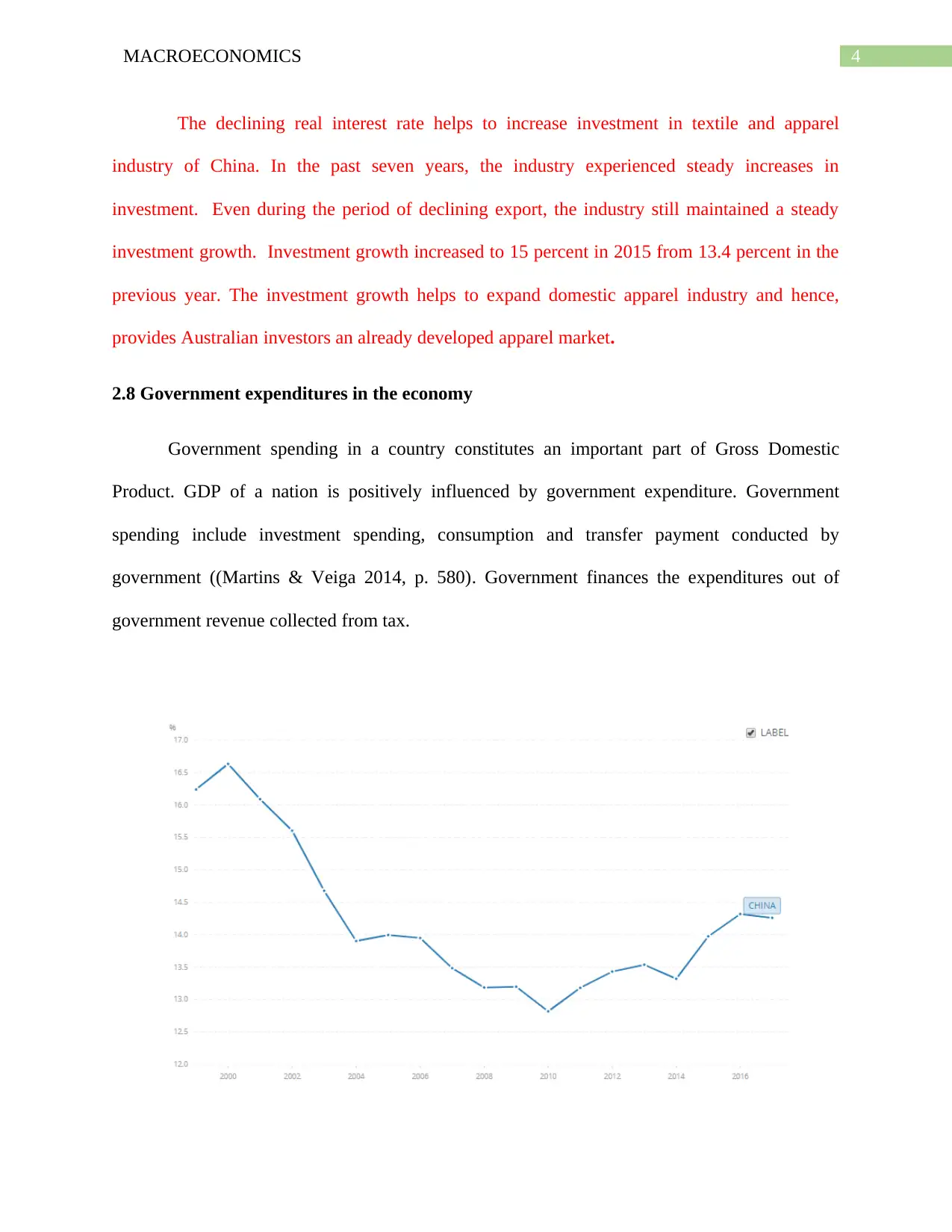
4MACROECONOMICS
The declining real interest rate helps to increase investment in textile and apparel
industry of China. In the past seven years, the industry experienced steady increases in
investment. Even during the period of declining export, the industry still maintained a steady
investment growth. Investment growth increased to 15 percent in 2015 from 13.4 percent in the
previous year. The investment growth helps to expand domestic apparel industry and hence,
provides Australian investors an already developed apparel market.
2.8 Government expenditures in the economy
Government spending in a country constitutes an important part of Gross Domestic
Product. GDP of a nation is positively influenced by government expenditure. Government
spending include investment spending, consumption and transfer payment conducted by
government ((Martins & Veiga 2014, p. 580). Government finances the expenditures out of
government revenue collected from tax.
The declining real interest rate helps to increase investment in textile and apparel
industry of China. In the past seven years, the industry experienced steady increases in
investment. Even during the period of declining export, the industry still maintained a steady
investment growth. Investment growth increased to 15 percent in 2015 from 13.4 percent in the
previous year. The investment growth helps to expand domestic apparel industry and hence,
provides Australian investors an already developed apparel market.
2.8 Government expenditures in the economy
Government spending in a country constitutes an important part of Gross Domestic
Product. GDP of a nation is positively influenced by government expenditure. Government
spending include investment spending, consumption and transfer payment conducted by
government ((Martins & Veiga 2014, p. 580). Government finances the expenditures out of
government revenue collected from tax.
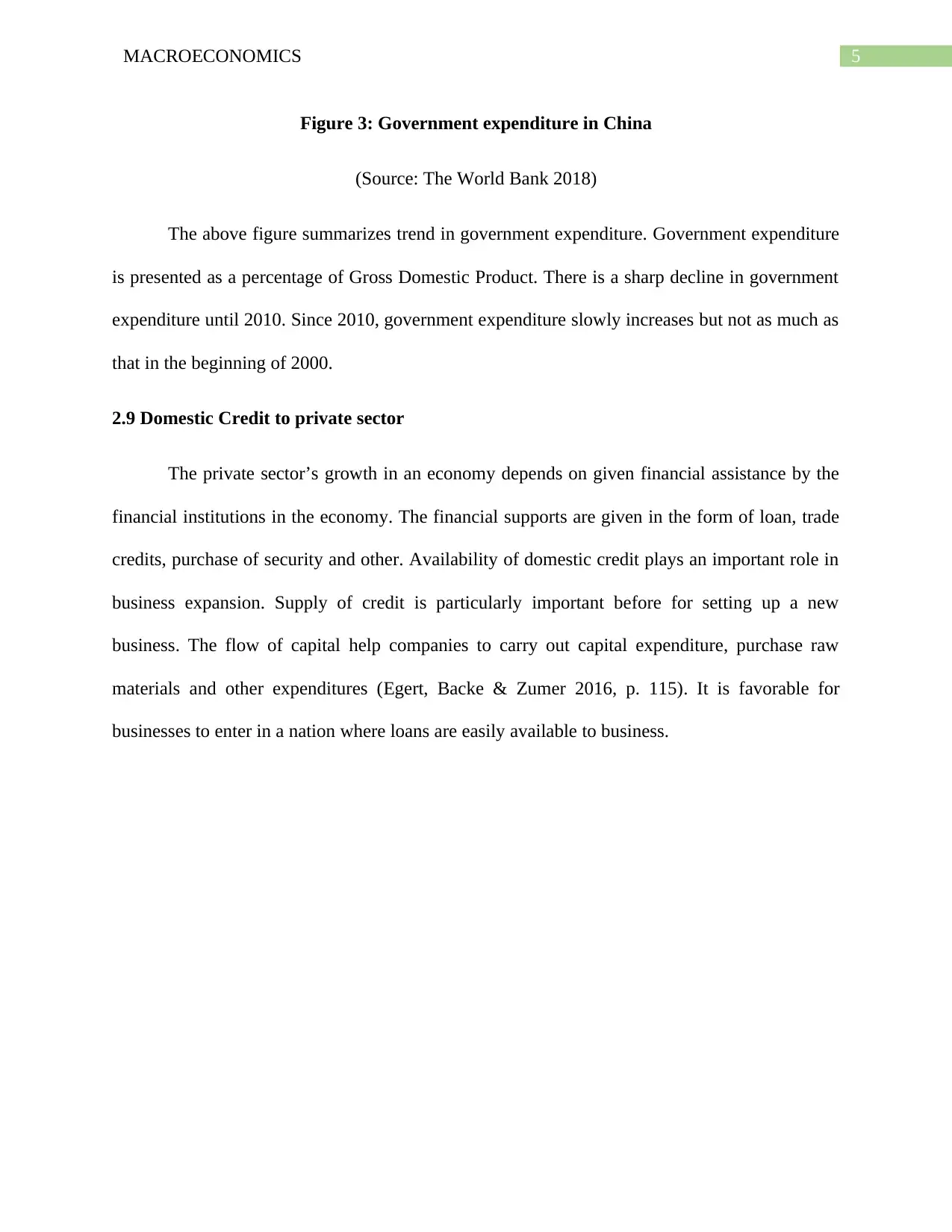
5MACROECONOMICS
Figure 3: Government expenditure in China
(Source: The World Bank 2018)
The above figure summarizes trend in government expenditure. Government expenditure
is presented as a percentage of Gross Domestic Product. There is a sharp decline in government
expenditure until 2010. Since 2010, government expenditure slowly increases but not as much as
that in the beginning of 2000.
2.9 Domestic Credit to private sector
The private sector’s growth in an economy depends on given financial assistance by the
financial institutions in the economy. The financial supports are given in the form of loan, trade
credits, purchase of security and other. Availability of domestic credit plays an important role in
business expansion. Supply of credit is particularly important before for setting up a new
business. The flow of capital help companies to carry out capital expenditure, purchase raw
materials and other expenditures (Egert, Backe & Zumer 2016, p. 115). It is favorable for
businesses to enter in a nation where loans are easily available to business.
Figure 3: Government expenditure in China
(Source: The World Bank 2018)
The above figure summarizes trend in government expenditure. Government expenditure
is presented as a percentage of Gross Domestic Product. There is a sharp decline in government
expenditure until 2010. Since 2010, government expenditure slowly increases but not as much as
that in the beginning of 2000.
2.9 Domestic Credit to private sector
The private sector’s growth in an economy depends on given financial assistance by the
financial institutions in the economy. The financial supports are given in the form of loan, trade
credits, purchase of security and other. Availability of domestic credit plays an important role in
business expansion. Supply of credit is particularly important before for setting up a new
business. The flow of capital help companies to carry out capital expenditure, purchase raw
materials and other expenditures (Egert, Backe & Zumer 2016, p. 115). It is favorable for
businesses to enter in a nation where loans are easily available to business.
⊘ This is a preview!⊘
Do you want full access?
Subscribe today to unlock all pages.

Trusted by 1+ million students worldwide
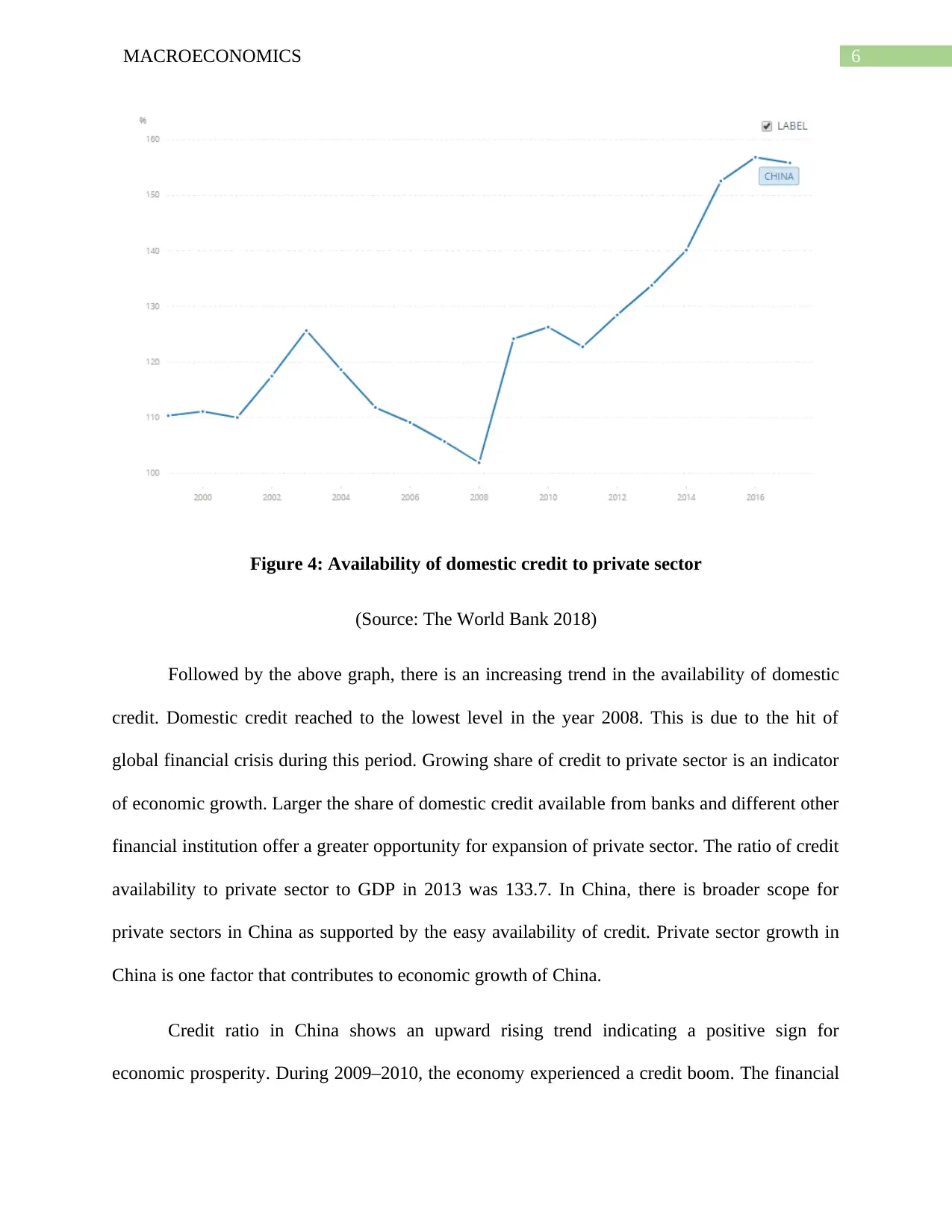
6MACROECONOMICS
Figure 4: Availability of domestic credit to private sector
(Source: The World Bank 2018)
Followed by the above graph, there is an increasing trend in the availability of domestic
credit. Domestic credit reached to the lowest level in the year 2008. This is due to the hit of
global financial crisis during this period. Growing share of credit to private sector is an indicator
of economic growth. Larger the share of domestic credit available from banks and different other
financial institution offer a greater opportunity for expansion of private sector. The ratio of credit
availability to private sector to GDP in 2013 was 133.7. In China, there is broader scope for
private sectors in China as supported by the easy availability of credit. Private sector growth in
China is one factor that contributes to economic growth of China.
Credit ratio in China shows an upward rising trend indicating a positive sign for
economic prosperity. During 2009–2010, the economy experienced a credit boom. The financial
Figure 4: Availability of domestic credit to private sector
(Source: The World Bank 2018)
Followed by the above graph, there is an increasing trend in the availability of domestic
credit. Domestic credit reached to the lowest level in the year 2008. This is due to the hit of
global financial crisis during this period. Growing share of credit to private sector is an indicator
of economic growth. Larger the share of domestic credit available from banks and different other
financial institution offer a greater opportunity for expansion of private sector. The ratio of credit
availability to private sector to GDP in 2013 was 133.7. In China, there is broader scope for
private sectors in China as supported by the easy availability of credit. Private sector growth in
China is one factor that contributes to economic growth of China.
Credit ratio in China shows an upward rising trend indicating a positive sign for
economic prosperity. During 2009–2010, the economy experienced a credit boom. The financial
Paraphrase This Document
Need a fresh take? Get an instant paraphrase of this document with our AI Paraphraser
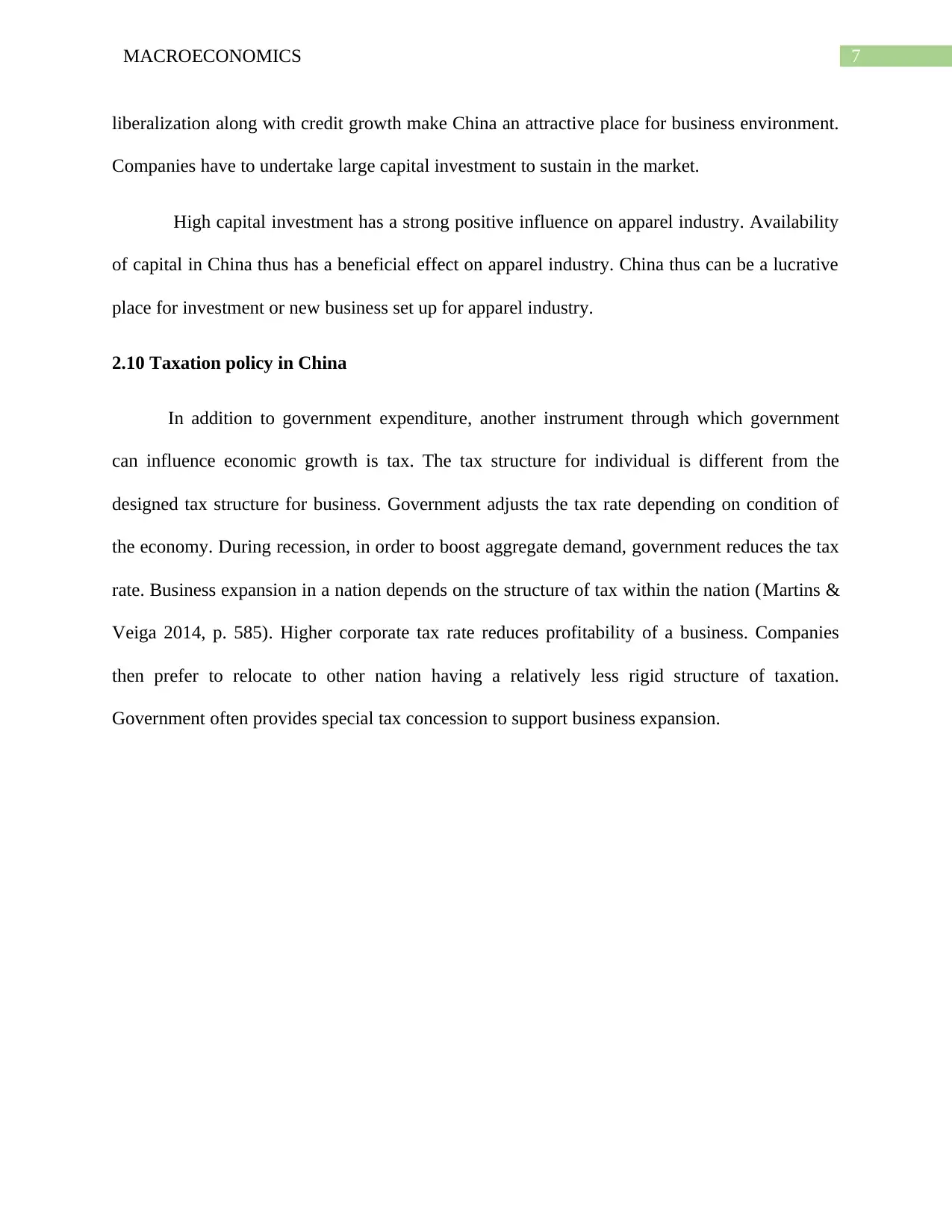
7MACROECONOMICS
liberalization along with credit growth make China an attractive place for business environment.
Companies have to undertake large capital investment to sustain in the market.
High capital investment has a strong positive influence on apparel industry. Availability
of capital in China thus has a beneficial effect on apparel industry. China thus can be a lucrative
place for investment or new business set up for apparel industry.
2.10 Taxation policy in China
In addition to government expenditure, another instrument through which government
can influence economic growth is tax. The tax structure for individual is different from the
designed tax structure for business. Government adjusts the tax rate depending on condition of
the economy. During recession, in order to boost aggregate demand, government reduces the tax
rate. Business expansion in a nation depends on the structure of tax within the nation (Martins &
Veiga 2014, p. 585). Higher corporate tax rate reduces profitability of a business. Companies
then prefer to relocate to other nation having a relatively less rigid structure of taxation.
Government often provides special tax concession to support business expansion.
liberalization along with credit growth make China an attractive place for business environment.
Companies have to undertake large capital investment to sustain in the market.
High capital investment has a strong positive influence on apparel industry. Availability
of capital in China thus has a beneficial effect on apparel industry. China thus can be a lucrative
place for investment or new business set up for apparel industry.
2.10 Taxation policy in China
In addition to government expenditure, another instrument through which government
can influence economic growth is tax. The tax structure for individual is different from the
designed tax structure for business. Government adjusts the tax rate depending on condition of
the economy. During recession, in order to boost aggregate demand, government reduces the tax
rate. Business expansion in a nation depends on the structure of tax within the nation (Martins &
Veiga 2014, p. 585). Higher corporate tax rate reduces profitability of a business. Companies
then prefer to relocate to other nation having a relatively less rigid structure of taxation.
Government often provides special tax concession to support business expansion.
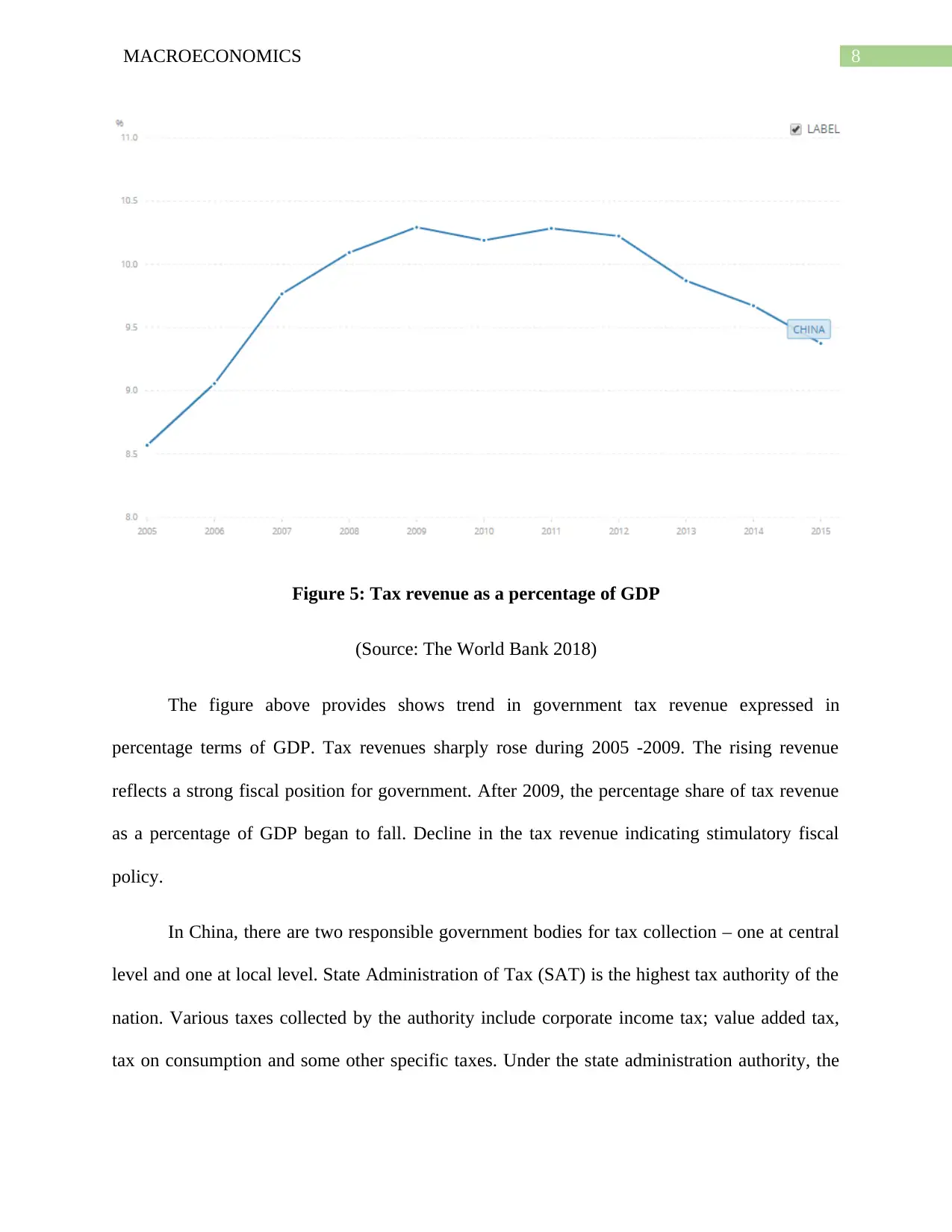
8MACROECONOMICS
Figure 5: Tax revenue as a percentage of GDP
(Source: The World Bank 2018)
The figure above provides shows trend in government tax revenue expressed in
percentage terms of GDP. Tax revenues sharply rose during 2005 -2009. The rising revenue
reflects a strong fiscal position for government. After 2009, the percentage share of tax revenue
as a percentage of GDP began to fall. Decline in the tax revenue indicating stimulatory fiscal
policy.
In China, there are two responsible government bodies for tax collection – one at central
level and one at local level. State Administration of Tax (SAT) is the highest tax authority of the
nation. Various taxes collected by the authority include corporate income tax; value added tax,
tax on consumption and some other specific taxes. Under the state administration authority, the
Figure 5: Tax revenue as a percentage of GDP
(Source: The World Bank 2018)
The figure above provides shows trend in government tax revenue expressed in
percentage terms of GDP. Tax revenues sharply rose during 2005 -2009. The rising revenue
reflects a strong fiscal position for government. After 2009, the percentage share of tax revenue
as a percentage of GDP began to fall. Decline in the tax revenue indicating stimulatory fiscal
policy.
In China, there are two responsible government bodies for tax collection – one at central
level and one at local level. State Administration of Tax (SAT) is the highest tax authority of the
nation. Various taxes collected by the authority include corporate income tax; value added tax,
tax on consumption and some other specific taxes. Under the state administration authority, the
⊘ This is a preview!⊘
Do you want full access?
Subscribe today to unlock all pages.

Trusted by 1+ million students worldwide
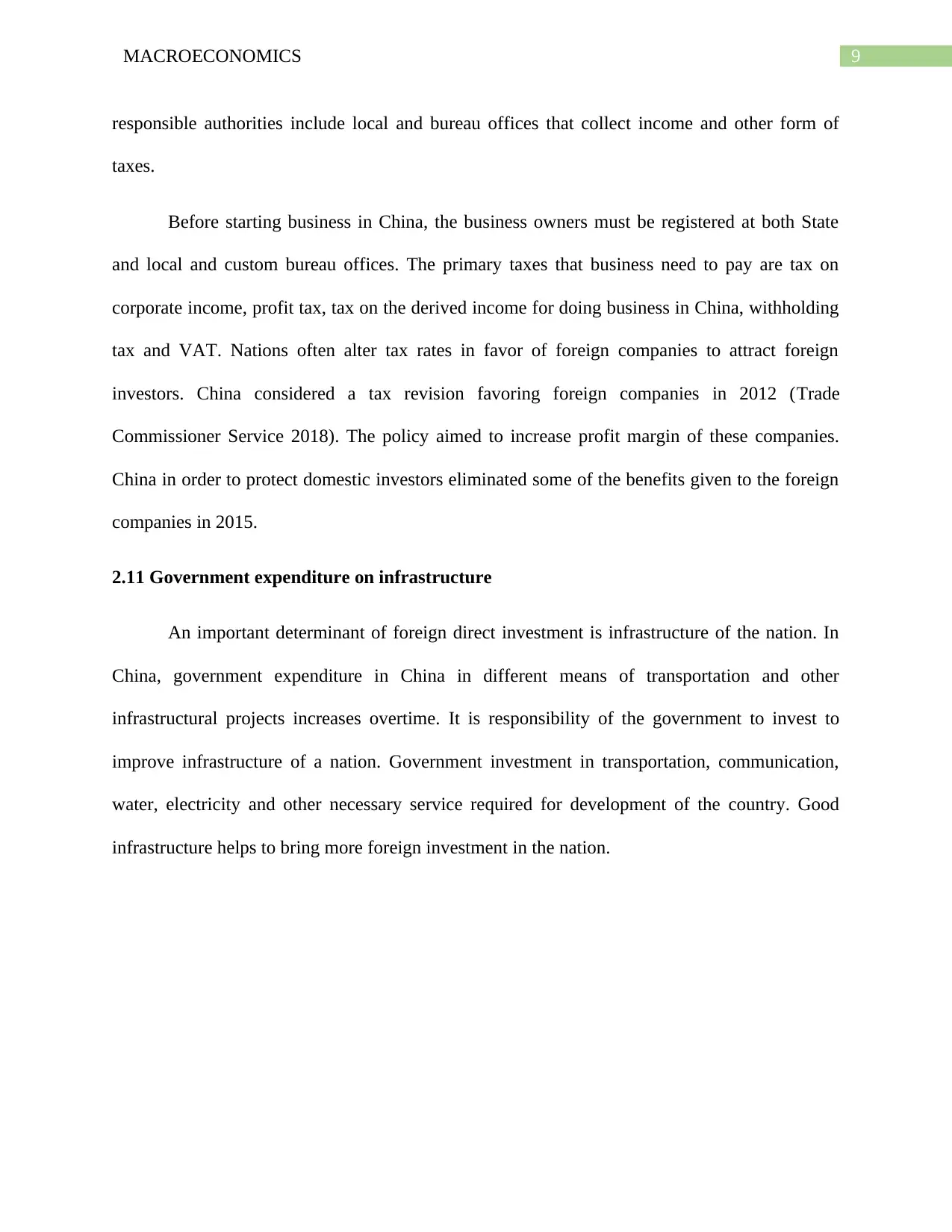
9MACROECONOMICS
responsible authorities include local and bureau offices that collect income and other form of
taxes.
Before starting business in China, the business owners must be registered at both State
and local and custom bureau offices. The primary taxes that business need to pay are tax on
corporate income, profit tax, tax on the derived income for doing business in China, withholding
tax and VAT. Nations often alter tax rates in favor of foreign companies to attract foreign
investors. China considered a tax revision favoring foreign companies in 2012 (Trade
Commissioner Service 2018). The policy aimed to increase profit margin of these companies.
China in order to protect domestic investors eliminated some of the benefits given to the foreign
companies in 2015.
2.11 Government expenditure on infrastructure
An important determinant of foreign direct investment is infrastructure of the nation. In
China, government expenditure in China in different means of transportation and other
infrastructural projects increases overtime. It is responsibility of the government to invest to
improve infrastructure of a nation. Government investment in transportation, communication,
water, electricity and other necessary service required for development of the country. Good
infrastructure helps to bring more foreign investment in the nation.
responsible authorities include local and bureau offices that collect income and other form of
taxes.
Before starting business in China, the business owners must be registered at both State
and local and custom bureau offices. The primary taxes that business need to pay are tax on
corporate income, profit tax, tax on the derived income for doing business in China, withholding
tax and VAT. Nations often alter tax rates in favor of foreign companies to attract foreign
investors. China considered a tax revision favoring foreign companies in 2012 (Trade
Commissioner Service 2018). The policy aimed to increase profit margin of these companies.
China in order to protect domestic investors eliminated some of the benefits given to the foreign
companies in 2015.
2.11 Government expenditure on infrastructure
An important determinant of foreign direct investment is infrastructure of the nation. In
China, government expenditure in China in different means of transportation and other
infrastructural projects increases overtime. It is responsibility of the government to invest to
improve infrastructure of a nation. Government investment in transportation, communication,
water, electricity and other necessary service required for development of the country. Good
infrastructure helps to bring more foreign investment in the nation.
Paraphrase This Document
Need a fresh take? Get an instant paraphrase of this document with our AI Paraphraser
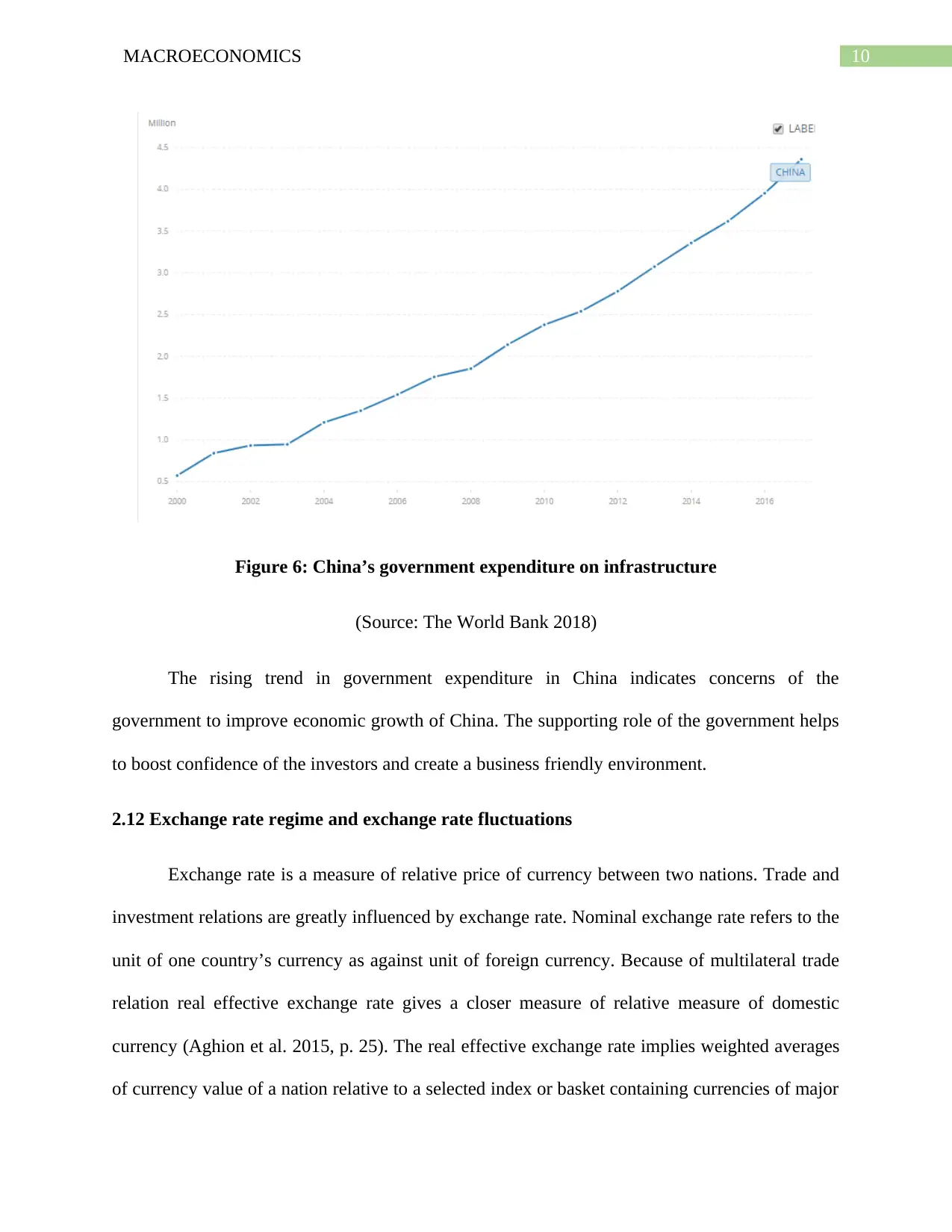
10MACROECONOMICS
Figure 6: China’s government expenditure on infrastructure
(Source: The World Bank 2018)
The rising trend in government expenditure in China indicates concerns of the
government to improve economic growth of China. The supporting role of the government helps
to boost confidence of the investors and create a business friendly environment.
2.12 Exchange rate regime and exchange rate fluctuations
Exchange rate is a measure of relative price of currency between two nations. Trade and
investment relations are greatly influenced by exchange rate. Nominal exchange rate refers to the
unit of one country’s currency as against unit of foreign currency. Because of multilateral trade
relation real effective exchange rate gives a closer measure of relative measure of domestic
currency (Aghion et al. 2015, p. 25). The real effective exchange rate implies weighted averages
of currency value of a nation relative to a selected index or basket containing currencies of major
Figure 6: China’s government expenditure on infrastructure
(Source: The World Bank 2018)
The rising trend in government expenditure in China indicates concerns of the
government to improve economic growth of China. The supporting role of the government helps
to boost confidence of the investors and create a business friendly environment.
2.12 Exchange rate regime and exchange rate fluctuations
Exchange rate is a measure of relative price of currency between two nations. Trade and
investment relations are greatly influenced by exchange rate. Nominal exchange rate refers to the
unit of one country’s currency as against unit of foreign currency. Because of multilateral trade
relation real effective exchange rate gives a closer measure of relative measure of domestic
currency (Aghion et al. 2015, p. 25). The real effective exchange rate implies weighted averages
of currency value of a nation relative to a selected index or basket containing currencies of major
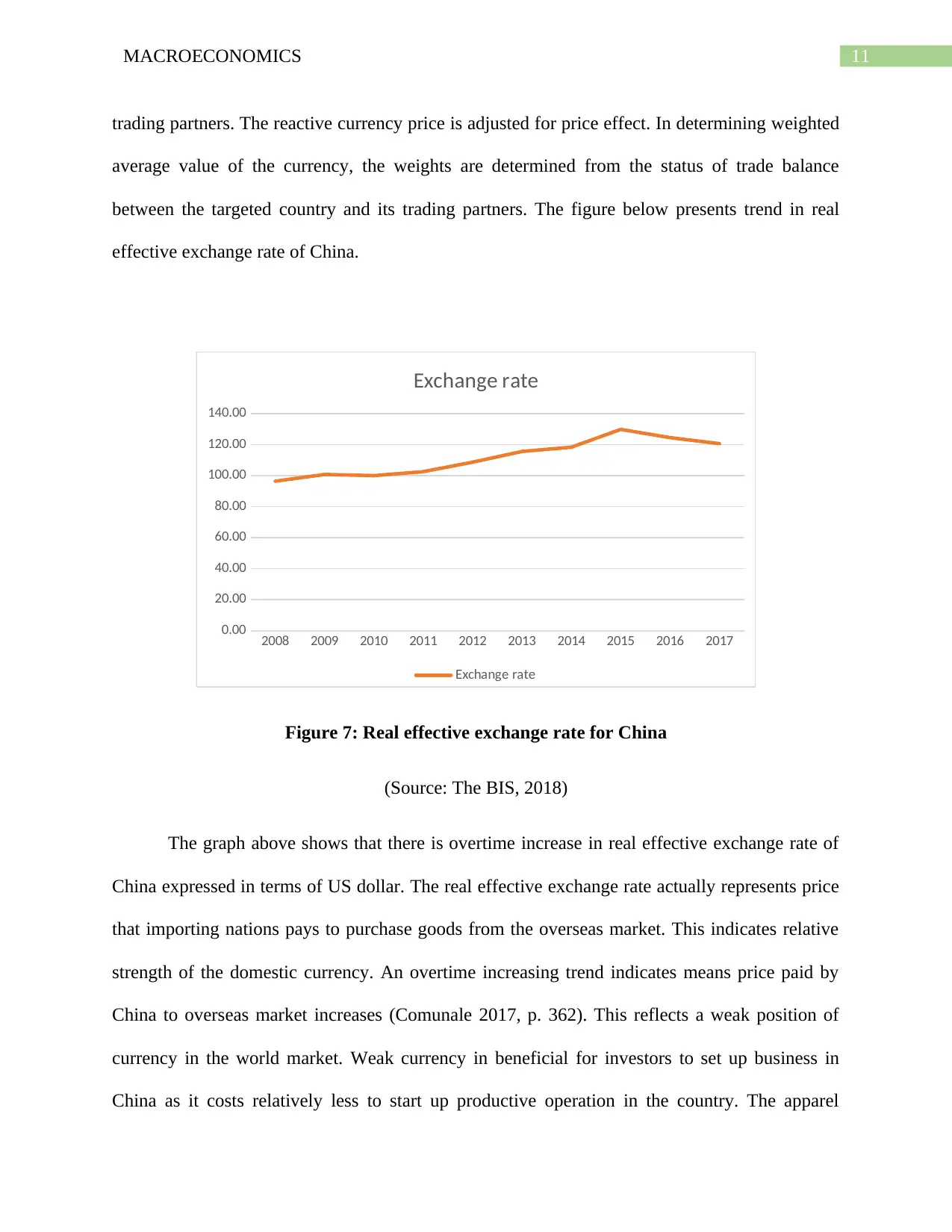
11MACROECONOMICS
trading partners. The reactive currency price is adjusted for price effect. In determining weighted
average value of the currency, the weights are determined from the status of trade balance
between the targeted country and its trading partners. The figure below presents trend in real
effective exchange rate of China.
2008 2009 2010 2011 2012 2013 2014 2015 2016 2017
0.00
20.00
40.00
60.00
80.00
100.00
120.00
140.00
Exchange rate
Exchange rate
Figure 7: Real effective exchange rate for China
(Source: The BIS, 2018)
The graph above shows that there is overtime increase in real effective exchange rate of
China expressed in terms of US dollar. The real effective exchange rate actually represents price
that importing nations pays to purchase goods from the overseas market. This indicates relative
strength of the domestic currency. An overtime increasing trend indicates means price paid by
China to overseas market increases (Comunale 2017, p. 362). This reflects a weak position of
currency in the world market. Weak currency in beneficial for investors to set up business in
China as it costs relatively less to start up productive operation in the country. The apparel
trading partners. The reactive currency price is adjusted for price effect. In determining weighted
average value of the currency, the weights are determined from the status of trade balance
between the targeted country and its trading partners. The figure below presents trend in real
effective exchange rate of China.
2008 2009 2010 2011 2012 2013 2014 2015 2016 2017
0.00
20.00
40.00
60.00
80.00
100.00
120.00
140.00
Exchange rate
Exchange rate
Figure 7: Real effective exchange rate for China
(Source: The BIS, 2018)
The graph above shows that there is overtime increase in real effective exchange rate of
China expressed in terms of US dollar. The real effective exchange rate actually represents price
that importing nations pays to purchase goods from the overseas market. This indicates relative
strength of the domestic currency. An overtime increasing trend indicates means price paid by
China to overseas market increases (Comunale 2017, p. 362). This reflects a weak position of
currency in the world market. Weak currency in beneficial for investors to set up business in
China as it costs relatively less to start up productive operation in the country. The apparel
⊘ This is a preview!⊘
Do you want full access?
Subscribe today to unlock all pages.

Trusted by 1+ million students worldwide
1 out of 19
Related Documents
Your All-in-One AI-Powered Toolkit for Academic Success.
+13062052269
info@desklib.com
Available 24*7 on WhatsApp / Email
![[object Object]](/_next/static/media/star-bottom.7253800d.svg)
Unlock your academic potential
Copyright © 2020–2025 A2Z Services. All Rights Reserved. Developed and managed by ZUCOL.




